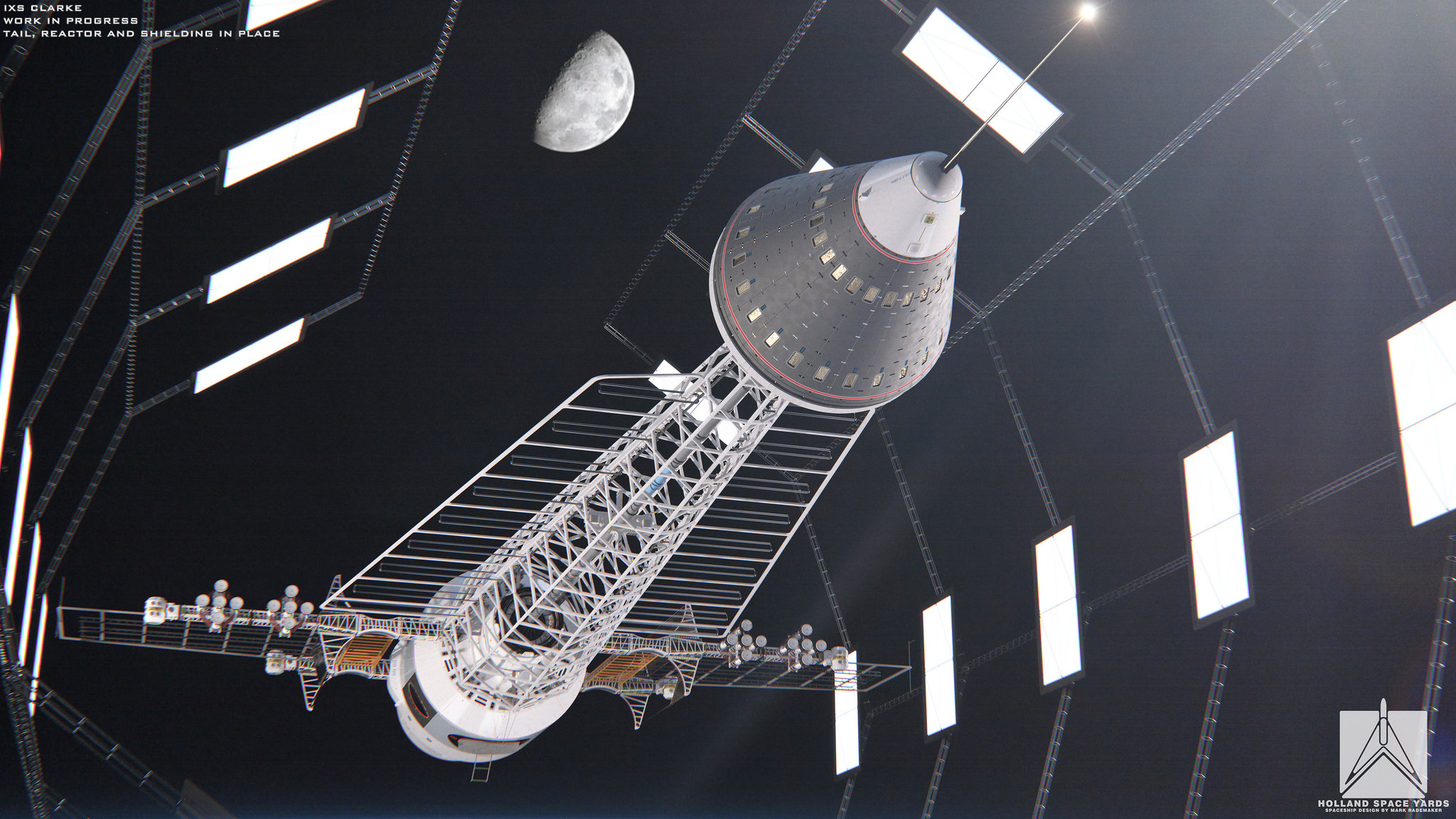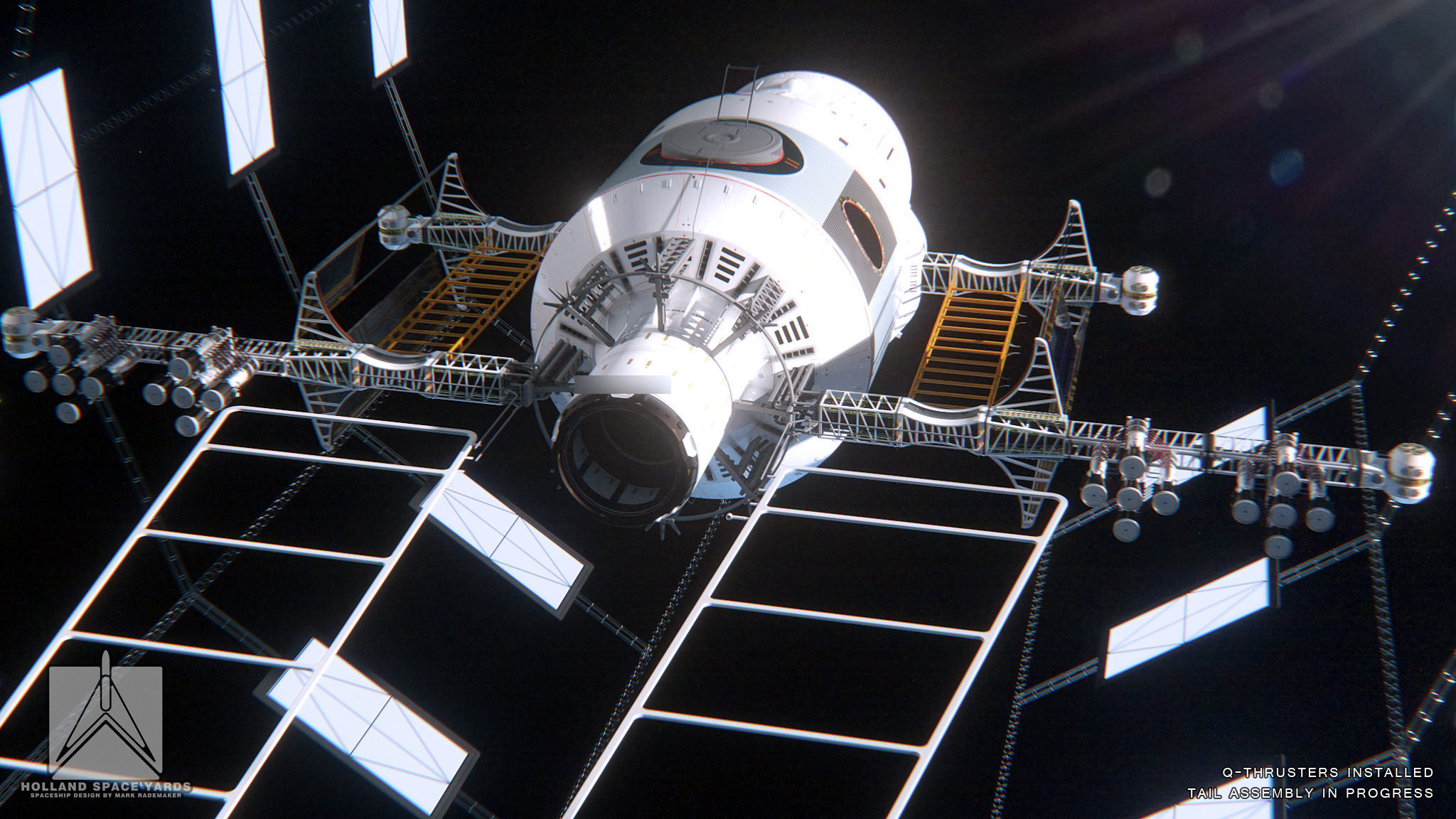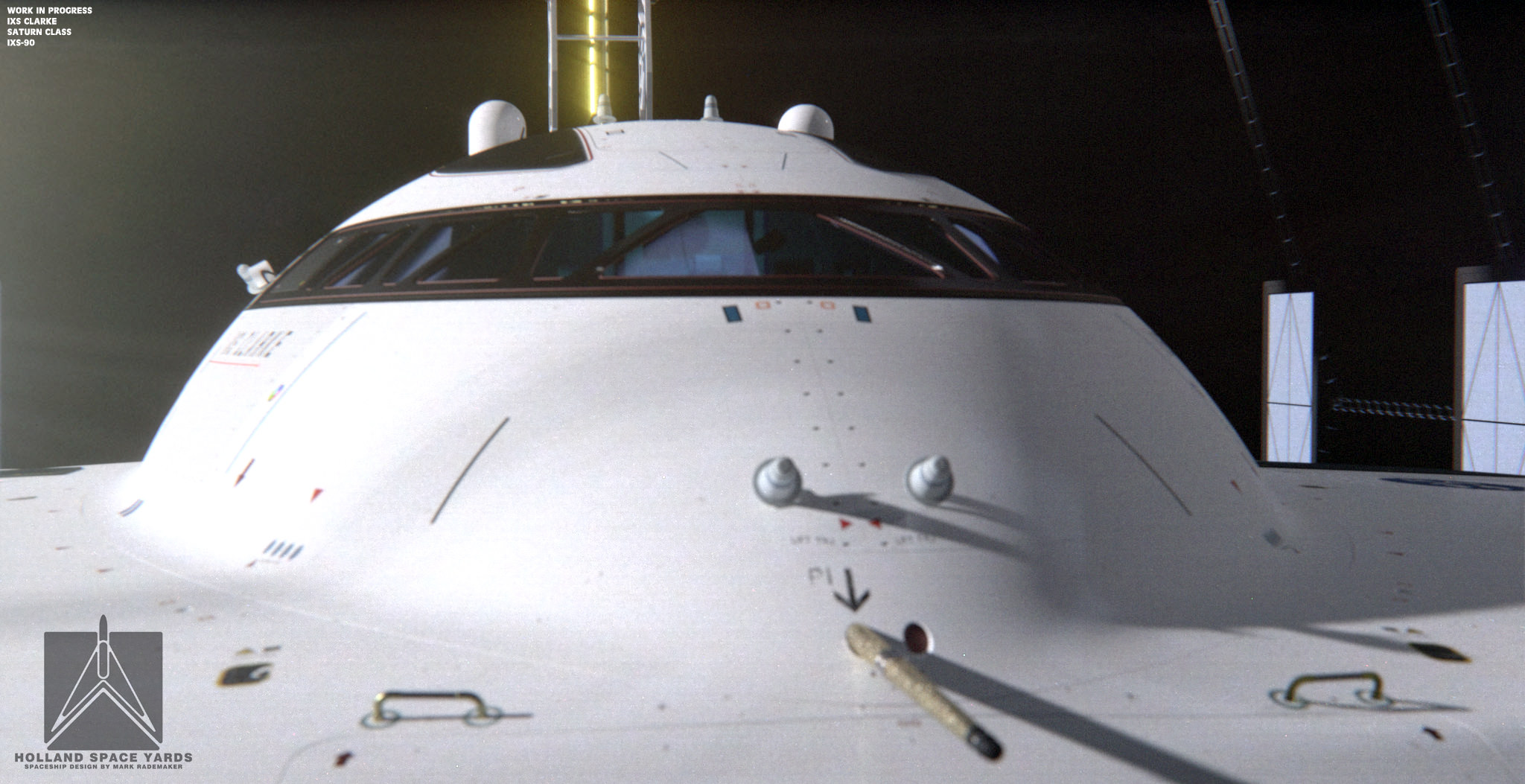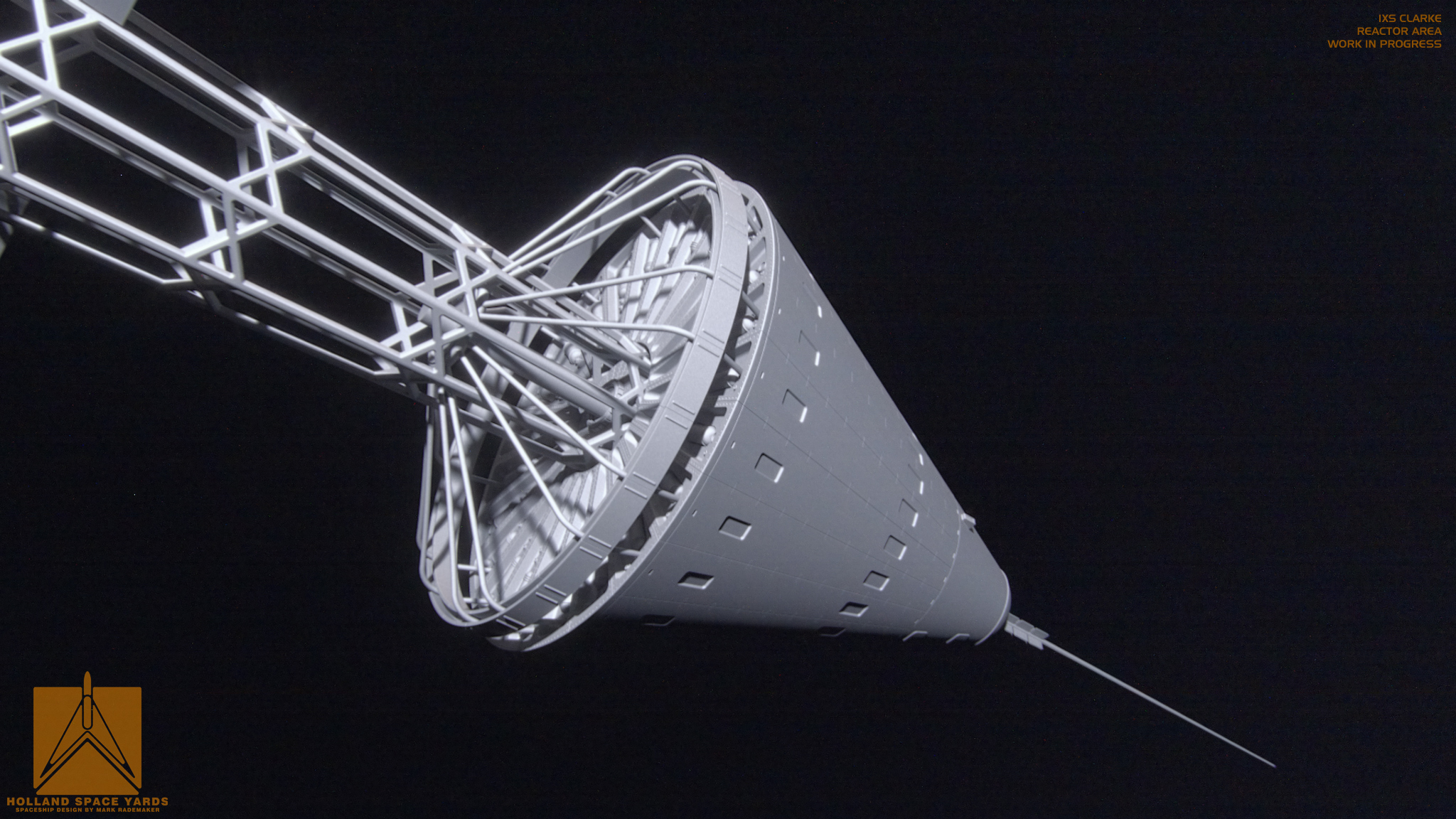













https://www.flickr.com/photos/yard2380/albums/72157652794160142/with/23010294546/


[Factual Fiction transcript]: Now, deuterium helium 3 – of any substance known in nature – has the highest energy per unit mass. Okay – antimatter has more energy per unit mass but it’s not found in nature you have to make it with energy from something else and currently that’s done with an efficiency of ten to the minus six. Uh, but the – ah, if you have deuterium, ah, helium 3 fusion you can make a rocket, ah, out of that. If you – it can either be magnetic confinement or inertial but either way to repel the plasma away from it. Um. If you dilute that plasmid with other mass – for example with hydrogen – you can lower the specific impulse and increase the thrust. And that would be done for interplanetary travel – or for instance move what I call ‘ice-troids’ which are asteroidal kind of objects made of volatile material like frozen ice or ammonia or whatever, okay, which you might want to do for terraforming purposes or for other reasons. Uh. But, if you actually wanna go to the stars, ah, you want to get the highest possible exhaust velocity, uhp, the deuterium helium 3 reaction gives you an ideal exhaust velocity of about seven percent the speed of light. And if you take into account inefficiencies that are likely to exist in a real rocket maybe you can get five percent the speed of light as an exhaust velocity. With appropriate staging rockets can be built to achieve about twice their exhaust velocity. For example, Space Shuttle main engine has an exhaust velocity of about four kilometers a second to achieve orbit the Shuttle moves to eight kilometers a second. So with various staging techniques and so forth you can get a rocket up to about twice its exhaust velocity.
So if you have a rocket that can do about five percent the speed of light, exhaust velocity you can make starships that have ten percent the speed of light final velocity. Then once they get up to speed I believe interstellar spacecraft can be slowed down using a magnetic sail which is basically deploying a loop of super-conducting wire which is in interstellar space creating a magnetic field, using that – it, it it, basically that would repel the interstellar plasma that would create drag, interstellar gas would be ionized and turned into plasma and repelled its just like solar wind hitting the Earth’s magnetosphere and it goes around it many of you have seen diagrams of that kind of thing. Well that actually creates drag around the Earth – fortunately not that much so we’re not falling into the sun at the moment, but, the, uh, it could be used to slow down interstellar spacecraft down to the – what you might call interplanetary class velocities, at which point more conventional technologies could be used to maneuver to the planet of interest.
So, and, and I might comment upon this. Fusion is a promising energy source for Earth, um, the program was going fairly well until the 1980s when it was internationalized. Ah, and, ah – no I mean that, because I worked in the fusion program. Until the 1980s we had a rather dynamic program because of the competition of the US program against the Soviet program the European program the Japanese program. All four were constantly challenging, trying to upstage each other at conferences, show their latest results their plans for the next machine and so forth – and this put some competitive drive into it. Ah, around 1985 the bureaucrats got together and said, “why are we doing this wasteful competition, let’s merge our programs into this thing called ITER” – the International Tokamak Experimental Reactor – it then took them thirty years to agree on where to put it. But they went to a lot of fun meetings in the meantime in Kyoto Geneva everywhere. And, ah, and and and the progress basically stopped after 1990, when no new national machines were made.
But we’re now moving into a more affluent world, and, just as we are seeing privately funded spacecraft companies we’re going to see privately funded fusion companies. Ah, because there’ll be people in the private sector who have resources to give this kind of thing a try. And I think we’ll have much more determined kinds of programs focused kinds of programs and I think it will eventually succeed.
You know fusion, the other thing about fusion, is, uh – well put it this way, steam engines were first developed for, um, pumping out mines, of water. But they didn’t really become efficient until they were developed for the purpose of propelling steam, boats. And nuclear reactors – the first practical incarnation of the nuclear reactor was to propel submarines, okay, and uh, I think developing fusion reactors for space propulsion might put the discipline on it to make inexpensive efficient fusion reactors which could then become available for commercial utilization. So I think there’s ah, ah, interplay here, between technology that’s developed for spaceflight and spaceflight using that technology to make much more available various resources for Earth, and as well as practical energy resource for Earth, and, as that technology’s developed towards its limit opening up a path to the stars.
The biggest problem in the world today is poverty. It’s not global warming or terrorism. Poverty. Poverty kills people. Through starvation, malnutrition, disease, ignorance, brutality, through every mechanism we can think of. We cannot be satisfied with the way things are. We cannot stop progress. No one in this VR would be satisfied if they were at half the world average. Or below half the world’s average – which half the world’s population is.
The main issue here is the continuation of progress, ok, there, there’s really, two ideas in contest here, on, on Earth, and, they have very real consequences. Ideas have consequences. Okay, there is this idea – which is essentially anti-humanist – uh, which is uh, that the world’s resources are fixed, and so, each additional person is a detriment to the well-being of everyone else, and, every nation is fundamentally the enemy of every other nation, and, every race the enemy of every other race, um, and ah, we should all try to keep each other down, okay, and, you know, the the the only outcome of this world view can be stagnation tyranny war and genocide. And in fact we’ve seen this. Uh, in the twentieth century. Hitler 1941 the laws of existence require killing so that the better may live. Okay, you know, and, and if these ideas are accepted now they could lead to the worst ideas you could possibly imagine.
I mean, if these ideas are accepted by the Chinese leadership for example then the existence of the United States population is intolerable because we’re four percent of the world’s population using twenty-five percent of the world’s oil. On the other hand – and if these ideas are accepted by American strategic thinkers they can have nothing but animosity toward the rise of China and other third-world to affluence ‘cause now there’s going to use up the oil that we want and so forth. Okay, but, if you take the other point of view, that human beings on net are creators – and by the way, this idea is demonstrably true, because if human beings on average destroyed more than they created there’d be nothing here. Okay.
It must be the case that human beings on average create more than they destroy, but, and if you embrace that truth, then, you see every new person born on the world as potentially a friend, every nation a friend and potentially a friend of every other nation. The US is the greatest friend of China not just because we buy their DVD players but because that four percent of the world’s population is producing half the world’s inventions. It’s true, we are. But we can be proud of that because we’d be a lot better off if the Chinese were doing their share so it’s really good for us if the sons and daughters of Chinese peasants go to the university to become scientists and engineers, so they can start contributing their talent to the general flow of human progress. So we’re not enemies at all. Okay, because, the real resource is human creativity. Okay, so, the, and, and the only thing sustainable is human progress – if you try to enforce stasis on society and limit us to one particular technology or form of resources, yeah then that one will run out. It is the capacity to create that creates resources.
Even early stage pioneer settlements on Mars, the Outer Solar System, or on multi-generational interstellar voyages will have police, detectives, judges, and so on. Their activities should be as transparent as possible – as well as the activities of all settlers. Now that humans are unable to keep secrets from certain technologies, it may be important that these technologies and their revelations be known and open to analysis by us all: a Democratic Panopticon.
“Autonomous robotic weapons would concentrate too much power in too few hands. And that would be corrosive to representative government. Let’s make sure, for democracies at least, killer robots remain fiction.”
This year’s theme: Project Daedalus
In honor of Martiniere’s featured cover artwork for January 2013’s exploration-dedicated issue of National Geographic, envisioning the Daedalus interstellar spacecraft, the theme for this year’s FarMaker Speed Sketch contest is “Project Daedalus”.
For further inspiration and reference sources, see Gallery of Daedalus & Icarus and Daedalus is the First and only ‘Starship design’ in History.
Also, be sure and check out Stephan Martiniere’s January 2013 “Explore” illustrations for National Geographic. Winners of the contest, which will be judged by illustrator and concept artist Stephan Martiniere, a guest of honor and keynote speaker at Starship Congress, will be included in an upcoming book on Project Daedalus. Entrants may spend between 5 minutes and 1.5 hours sketching concept art on the following themes:
Building: Interstellar tech helps a city thrive on Earth, keeping shipyards busy. What is it like?
Sealed in an envelope on the outside of which he wrote: “The Last Migration. The notes should be read thoroughly only by an optimist!”. Goddard was 35 years old and the notes were written more than six years before he would conduct the world’s first rocket flight using liquid propellants.
He wrote a condensed version and titled it The Ultimate Migration, which we are delighted to reproduce here in full and in the form in which it was written, uncorrected for grammar:
1 Possibility
Will it be possible to travel to the planets which are around the fixed stars, when the Sun and the Earth have cooled to such an extent that life is no longer possible on the Earth?
To answer this question, it is necessary to answer two others; first, will it be possible to unlock, and control, intra-atomic energy? and second, if the first cannot be answered in the affirmative, will it be possible to reduce the protoplasm in the human body to the granular state, so that it can withstand the intense cold of interstellar space? It would probably be necessary to dessicate the body, more or less, before this state could be produced. Awakening may have to be done very slowly. It might be necessary to have people evolve, through a number of generations, for this purpose.
2 Means of Transportation
If it is possible to unlock, and to control, intra-atomic energy, or even to store up great quantities of energy in artificial atoms, the transportation can be a comparatively simple matter.
In the first place, it would be easy to attain the requisite speed for a reasonably short trip. Further, a large body could be used as the vehicle, such as an asteroid or a small moon. In this case life could be continued, if the body were made as poor a (heat) radiator as possible; the radioactivity furnishing light and heat. Of course, there is the possibility that after many thousands of years, the characteristics and natures of the passengers might change, with the succeeding generations.
A large body would also afford protection against meteors, if these occur in interstellar space.
If it is not possible to obtain and control atomic energy, hydrogen and oxygen, burned and ejected from a magazine rocket apparatus must be used, aided by solar energy, to get up speed, and leaving the Solar System with such a velocity that, at a great distance from the Solar System, the speed will be 3 to 10 miles per second. This will, of course, necessitate a very large apparatus, initially, unless solar energy can be used over a considerable time, to get up speed, either by passing through the Solar System from end to end, crossing as far from the Sun as possible, or spiralling outward until sufficient speed has been obtained.
The pilot should be awakened, or animated, at intervals, perhaps of 10,000 years for a passage to the nearest stars, and 1,000,000 years for great distances, or for other stellar systems. To accomplish this, a clock operated by a change in weight (rather than by electric charges, which produce too rapid effects) of a radiation substance, should be used. Any substance for us as a spring should be tested for permanent set at low temperatures. It might be necessary to use the pressure of the gases generated by the radioactivity. This would amount to a radium alarm clock. The initial motions produced by the pilot should be controlled by small motions of the fingers. Energy for the various operations could probably be best stored as electric charges produced, and replenished, by radioactivity, rather than, say by super-conductors, or by chemical substances that might change with time. Probably most chemical substances would remain very inert at the low temperature of space. This awakening would, of course, be necessary in order to steer the apparatus, if it became off its course.
3 Where would the journey be made to?
The most desirable destination would be near a large sun or twin suns, on a planet like the Earth, but of course, more distant from the sun or suns, so that the temperature will not be high, the planet being in the early stage of development. Here, further development of the race could take place for many ages before the sun or suns became too cool to support life.
The destination should be in a part of the sky where the stars are thickly clustered, so that further migration would be easy; the stars being preferably hydrogen, or new, stars.
Because of possible danger from meteoritic matter in space, expeditions should be sent to all parts of the Milky Way where new stars are thickly clustered, so that there will be considerable chance of one or more expeditions or parties making a landing.
With each expedition there should be taken all the knowledge, literature, art (in a condensed form), and description of tools, appliances, and processes, in as condensed, light, and indestructible a form as possible, so that a new civilisation could begin where the old ended.
4 Is this to be expected?
The only barrier to human development, or advancement, is ignorance, and this is not insurmountable.
If the above is not possible, or desirable, granular protoplasm, suitably enclosed, might be sent out of the Solar System; this protoplasm being of such a nature as to produce human beings eventually, by evolution.
John S. Lewis: Two years ago, I used this same podium, (what Teddy Roosevelt referred to as a “bully pulpit”) to look forward about 600 years into the future. Tonight, I’d like to reverse the tables, and look back. An anniversary is always a good time to look back, and tonight it’s most appropriate to look back twenty years, to a time when I had not yet developed an interest in space resources. It’s hard to believe, but it was actually eighteen years ago that I joined Gerry O’Neill’s bandwagon. It was twenty years ago that Gerry founded SSI. We all entertain a wide variety of different goals, and differ in the things that we wish to achieve, but we also still follow Gerry’s dream even when our individual preferences differ.
The events of the last twenty years have so far failed to gratify our desires, but they have given us a wide range of new discoveries of new resources that can be brought to bear on achieving those goals: ice in the polar regions of the Moon and Mercury; completely unforeseen armadas of Earth-approaching asteroids; tantalizing hints of a wet and wild early history of Mars; even evidence that suggests the presence of rudimentary life forms on Mars. Many of us have chosen goals inspired by one or more of these discoveries; or, shaped by them, we have favored such goals as building a polar base on the Moon or an equatorial solar power farm on the Moon; building space habitats, sending an expedition to Mars; exploiting the mineral wealth of nearby asteroids, building Solar Power Satellites out of space-derived materials, or some combination of these.
But it is not any one of these goals that draws us all together and defines our common interest and purpose. It’s something deeper. At the last conference banquet two years ago I developed the idea that the greatest resource in the solar system is human intelligence. If there is anything that draws us all together, it is the common desire to liberate that resource; to so shape the future as to give our descendants a wide and ever increasing range of choices about their own futures. To do so requires both access to resources and education, which is access to knowledge. It is futile for us to plan their lives and design their society, although some continue to do so. What we should desire is to design the future in such a way that they will be free to make such decisions for themselves. We need to trust them as we ourselves would want to be trusted.
Looking back over the twenty years of SSI, I have several times tried to articulate what I see as SSI’s greatest value – and as Gerry’s greatest contribution. As I said once before in this meeting to disbelieving ears, I believe it is not that Gerry or SSI has been simply visionary. That word too often implies “divorced from contact with reality” or “impractical.” Quite the opposite: Gerry saw a vision that many before him and many since him have also seen, but he was not content to perpetuate it as a vision or an abstraction. Instead, he showed us a path: and not necessarily the only possible path, but a visible path, a demonstration in principle of how to get from where we are now to that land of vision. He married heaven with Earth through sound physics and contagious enthusiasm. He would have rejoiced in the news of rich new resources in nearby space. He would have hastened to enlist them in the service of mankind and to fold them into his specific plans in ways that perhaps would surprise us by their inventiveness. But he would have responded and changed in response to these events.
Tonight I want to take a few minutes to trace back the visionary tradition in space to its earliest roots and antecedents. I cannot attempt more than a very superficial survey in the short amount of time that I have. I place upon you the charge to buy my book when it appears. I know many of you say, “I don’t have time to read.” But you don’t understand: you don’t need to read it, just buy it! I will begin by tracing that vision from the date twenty years ago when Gerry founded SSI, back to its source , I will then leap all the way back to the beginning of human records and dash forward and touch a few points of our understanding of the Universe. If I don’t run out of voice or interest, I will tie these two stories together in my conclusion. By completing this “eternal round” I hope to weave our knowledge and understanding of the Universe, and our sense of humanity’s place in it, into a single small tapestry.
First I ask, “What were the physically meaningful visions of space travel that preceded the founding of SSI?” I exclude here for the moment those things that I have been previously deprecated as merely visionary. I will emphasize developments that seem to have relevance to real physics, and really going into space, and neglect writings set in space for reasons of satire or political polemic. Let us go back now to the time in 1977, a mere twenty year jump that will prove to be the first step in a lengthy trip that will go back several thousand years. The space age was then in full swing: in fact, we were already past the bloom of the rose. The Apollo program had passed apogee and returned to Earth and was already nestled safely in museums. The space age, as we all knew, was based on a tradition of rocketry that had been developed beginning principally in the 1930’s.
The 1930’s were a period of tremendous excitement in the world of rocketry. The Verei fur Raumschiffahrt in Germany, the British Interplanetary Society, The American Interplanetary Society (which was later given the more staid and respectable name of the American Rocket Society) the GIRD Hydrodynamical Institute in St. Petersburg, and Goddard’s own rocket-testing activities were all in full swing at that time. Rocketry was already highly international, although it had very few triumphs to point to.
But a vision of the possibility of space travel, based soundly upon physical theory, was loose among us. (Remember, we’re going back in time, so don’t look for logical sequence here – look for anti-sequence. It’s one of the perils of time travel). In 1930 Olaf Stapledon, one of my heroes, wrote his marvelous novel, Last and First Men. It still has the capacity to boggle the mind of many people, especially those who have been raised on low-quality science fiction. Stapledon is too rich for their blood. Stapledon had a vision of the future of mankind that stretched millions and millions of years into the future, with post-human races succeeding one another; with mankind emigrating to Venus and then to Neptune, and then to points unknown. Stapledon was not at all concerned with technical details, but he assumed tacitly that rocketry would be the means by which our descendants would travel about the Solar System
Of course, he was writing just one year after the 1929 publication of Herman Oberth’s book Wege zur raumschiffahrt, “Routes to Spaceship Travel.” Oberth’s book was close to an encyclopedic treatment of the subject, and was available to the world. At that time, many people who had heard nothing about the subject read his book and suddenly found it compelling. Some have said that his influence was the immediate impetus for development of all the societies devoted to rocketry and space travel in the 1930s. But Oberth was, in fact, writing several years after Robert Goddard began flying liquid fuel rockets in 1926. There is a logical connection between all of these events: there is a logical cause-and-effect relationship.
Herman Oberth wrote to Goddard after he found of the existence of Goddard’s 1919 book on rocketry, and expressed interest in getting a copy of the book. Oberth said that he himself was preparing a book manuscript on the subject. Goddard reacted with typical paranoia. He kept referring to the Transylvanian Oberth as “that German.” He was so afraid that Oberth was going to steal his ideas that he didn’t even respond to Oberth’s letter. Oberth’s second letter, with a copy of his partial book manuscript, arrived with a carbon copy of the first letter which he had sent.
He sent it because he was afraid that the first one had been lost in the mail, because Goddard had never responded. (I’m afraid that some of my correspondents do the same.) Far from being willing to engage in international collaboration, Goddard hastened to get patents. He spent a great deal of his attention during his career corresponding with his patent lawyers, perhaps as much as he spent at the test stand. But Goddard’s work had not inspired Oberth to take up rocketry: several years earlier, Oberth had submitted a doctoral dissertation on the physics of rocket propulsion and space travel to the university which he was attending in Germany – the University of Heidelberg. To confirm all your worst suspicions about the academic world, Oberth’s dissertation was rejected by the University. He had it published at his own expense several years later. In later years, Oberth tended to characterize himself as the visionary theorist and Goddard as a tinkerer with little imagination.
But we now know that four years before Oberth’s dissertation, in 1918, Robert Goddard had written a tract entitled The Ultimate Migration. To avoid quick publication of it, he sealed it into an envelope that had written on the outside, “special formula for silvering mirrors.” Fifty-five years later, an archivist happened to open the envelope to find out what was so important about silvering mirrors and found the manuscript. The Ultimate Migration describes the future of mankind in Stapletonian perspective up through the point where the Sun is becoming unstable and the human race needs to flee from the Solar System. To do so, they travel out to the asteroid belt, hollow out ten-mile-sized asteroids, convert the asteroids into space ships, and depart into the sunset— actually, in the opposite direction.
True, that’s visionary – but it was based on the physics of rocket propulsion. It was an interstellar slow boat — perhaps the first of that sort. But, unknown to Goddard, two years earlier, a professor at Pulkovo in St. Petersburg had maintained in a public record that rocket propulsion is necessary for getting around the Solar System and “will remain necessary until gravitation can be annulled, probably by electrical means.” Precisely what he had in mind is not clear, but Professor Tickov clearly was thinking ahead of his time. The year before that in 1915, a young lieutenant in the Austro-Hungarian army who as yet knew nothing of Goddard (this is the younger Hermann Oberth) had submitted a design for war rockets to the Austro-Hungarian Ministry of War. He received in return a very firm, short letter, thanking him for sending the products of his “fantasy,” and would he please forget these ideas.
Three years before that, however, a young post-doc in the Palmer Physical Laboratory of Princeton University was working on rocketry in his spare time unaware that anyone else in the world had similar interests. There he developed the friendship of Henry Norris Russell, the dean of American astronomy, the greatest astronomer America had produced to that time, the first man to systematize the physical properties of stars into a diagram relating luminosity to temperature and color. This post-doc also made the friendship of the chairman of the physics department W. F. Magie who was the inventor of the fluoroscope and quite a prominent physicist in his own right. This young post doc, Robert Goddard, was present here in Princeton at an interesting time in the history of the university. He was here and celebrated in a torch light parade the night that Woodrow Wilson was elected President of the United States. He joined a march to Wilson’s house and a great rousing sendoff for Wilson at the train station which was then located about where the University Store is now on campus, when Wilson departed to Washington, D.C. for the inauguration four months later.
Goddard had been keeping notebooks for years before that, as an undergraduate. These notebooks documented his ideas, some of them very advanced. About the same time, in 1913, Konstantin Edouardovich Tsiolkovskii published a science fiction novel entitled In the Year 2000; On the Rocket. In this fictional treatment, Tsiolkovskii wrote about a group of rich men, who in modern terms would be called “venture capitalists,” brought together by the conviction that it was possible to build a rocket and travel into space. They built a rocket fueled by hydrocarbons and liquid oxygen and proceeded to do so. 1912, by the way, is also the year that Edgar Rice Burroughs wrote A Princess of Mars and it’s also the year in which a French physicist by the name of Robert Esnault-Pelterie convened a conference on rocket propulsion in Paris. One of the results of that conference was the firm conclusion that rocket flight into space would not be possible until nuclear energy is tamed. Esnault-Pelterie was quite unaware of the existence of Tsiolkovskii; indeed, as late as the 1930s he refused to acknowledge Tsiolkovskii’s priority.
But I mentioned that Goddard kept notebooks as an undergraduate. Between 1908 and 1910, Goddard’s “green notebooks” included such novel ideas as multiple-stage rockets, an analysis of the importance of the hydrogen-oxygen rocket, the ion engine, solar thermal propulsion and a very interesting discussion in May of 1910 on the subject of the importance of the discovery of ice on the Moon. Goddard argued that, because ice could be extracted and processed into rocket propellants and life support materials, it would enable the existence of a base on the Moon and facilitate travel back and forth to the Moon. There is evidently nothing new under the Sun.
But even earlier, in 1905 through 1907, a Swedish astronomer by the name of Sverre Birkeland, working in complete isolation, carried out some rather interesting experiments that were not well documented and not published in his lifetime: he was experimenting with static tests of hydrogen-oxygen rockets. Of course, some people had been there earlier: in 1903, Konstantin Tsiolkovskii published his Exploration of Cosmic Space with Reaction Engines which was, like Oberth’s treatise of 1929, an encyclopedic overview of the capabilities of the rocket engine and the necessary physics, in which he pointed out the desirability of H-0 rockets. Of course, Tsiolkovskii started working on that years before it was actually published. We just keep pushing the frontier back. How far back can we go?
It seems that Tsiolkovskii was inspired in his interest in space travel by at least two previous authors. One of them was A. P. Fedorov, who wrote a book called A New Principle of Aeronautics which included a description of space flight. It was a non-technical book, but it was a book of inspirational vision. Not only was Tsiolkovskii inspired by that book, but so was Vladimir Vernadskii, the man who invented the concept of the “biosphere” and coined the word, “biosphere.” Fedorov’s book appeared in 1896. Tsiolkovskii also read and was inspired by Verne’s novels.
But as early as 1891 there was a man touring around Germany giving lectures on the subject of rocket propulsion! His name was Hermann Ganswindt. Ganswindt left no book by which to be remembered, only second-hand accounts by people who attended his lectures and were sufficiently startled. It appears that his ideas had no effect on those who followed him.
Even earlier, in 1880, unbeknownst to Fedorov or Vernadskii, there was a science fiction book written by a man named Percy Greg, entitled Across the Zodiac, in which he used an antigravity-powered ship complete with a hydroponic air recirculation system. We are now well back into the era in which many of these people did not influence those that followed after them, because their work was lost and was not accessible to those who followed. For example, Tsiolkovskii’s work was not available to Goddard. Tsiolkovskii’s work was not available to Oberth. They essentially had to re-invent the wheel. Oberth and Goddard, you could argue, could have had a free exchange of views; in fact, Oberth in the 1920s had great respect for Goddard and had done marvelous work on his own, but Goddard distrusted Oberth to the point where there was no free exchange of views.
So where did the idea of space travel first appear? In 1869, Edward Everett Hale wrote a story called “The Brick Moon” in The Atlantic Monthly. It’s the first account of a launch of an artificial Earth satellite that I’ve been able to discover. It was launched, not from Florida (which became de rigeur later), but from Maine, and it was launched by hydropower. They used the waterfall to spin up a giant flywheel, and used the flywheel to hurl the satellite into space. Edward Everett Hale, the science fiction writer, was also a very famous figure in the late 19th century. He recited an enormous, lengthy, and beautifully delivered address at the dedication of the Gettysburg Battlefield which was followed by Abraham Lincoln’s five minute polished gem of a speech. No one ever remembered the four hour oration of Edward Everett Hale. Hale, in his later years, became chaplain of the United States Senate at the end of his long and distinguished career. But Hale was writing about launching satellites in 1869, using a form of physics that we nowadays might associate with the slingatron concept. (If you look in detail to see how Hale did it, it’s unfortunately not really that clever.)
But even Hale’s story wasn’t the first example of launching something into space: Jules Verne had written From the Earth to the Moon in 1865. Verne used physics — but he happened to use lethal physics and didn’t know it. He had his astronauts fired out of a gun. But nonetheless, he tried to be physical. That was 1865, that was the earliest.
Well, not exactly, because there’s a really tantalizing clue. Desmond King-Hele has found a notebook dating from about 1780 that contains a very convincing sketch, not accompanied by any explanatory text; just a sketch that shows a tank of liquid hydrogen, a tank of liquid oxygen, pipes running from the two to a cylindrical combustion chamber with a nozzle on the end. This was found in the ordinary book of Erasmus Darwin, the grandfather of Charles Darwin. For those of you who have an appreciation of the ironies of history, you’ll probably like to know that in 1816 Mary Wollstonecroft Shelly, Percy Bysshe Shelly, Lord Byron and Byron’s doctor, John William Polidori, were sitting around one evening telling each other ghost stories and talking about the origins of life, the evolution of life on Earth, the nature of life, and what it meant to be human. Lord Byron challenged them all, in private and in isolation, to write a ghost story for the edification of the others. Mary, who was nineteen years old at the time, went to her room and wrote Frankenstein. She later said that she was inspired to think about these subjects by the conversation that evening that had centered upon a discussion of Darwin’s evolutionary theory. This is very interesting in 1816: The Origin of Species was written fifty years later! It was Erasmus Darwin’s evolutionary theory that inspired the writing of Frankenstein.
But sadly, these earliest contributions, such as Erasmus Darwin’s drawing, had no lasting effects. They were lost. They were ripples in the pond that had no visible consequences. However, two of those early writings did have lasting consequences: Jules Verne’s fiction inspired Tsiolkovskii and H.G. Wells’ fiction inspired Goddard. As a consequence of that inspiration they both went on to do memorable work. You never know what kind of a book will inspire people. We also will never know where we would be today if all these early sprouts of knowledge had not withered and died of neglect. That’s as far back as I can trace the physics of space travel. And now I’m going to get you really velocitated: I shall leap back to ancient history and touch very lightly, at least in chronological order this time, on some of our concepts about the Universe. I intend to skim this subject pretty lightly.
One of the earliest concepts of space that we have any account of is the idea of a ‘Loka’ in the Sanskrit literature from several thousand B.C. ‘Loka’ is an Indo-European root that gave rise to the Latin word locus and the English word location for place. It originally denoted “other worlds,” but in the Hindu and later in the Buddhist religion it meant a level of creation — something rather different from a place that you could travel to by train.
The early Greeks also touched upon the questions of the nature of the Universe. They started out with a picture of what they called a “Kosmos.” What was a Kosmos? First of all, it was centered on Earth. Earth was the point that defined the center, and all existence was a little sphere around it. The idea of the sphere was loosely established before Plato and firmly and irrevocably established after Plato on the basis of its alleged perfection. Thus, to the Greeks, we lived in a little capsule that was, in every sense, present for the purpose of surrounding and supporting our life here on Earth. We were the center of creation — a very Judeo-Christian attitude one might say, except that this was the Sixth Century B.C. in Greece, and it was Thales and Orpheus who were writing on the subject.
In the Fifth Century the early atom ists, who included Democritus and Leucippus, emphasized that all creation is built out of little building blocks, and that there are universal laws that govern the behavior of these building blocks. Therefore, the fact that these building blocks could organize to make a world, our Earth, implied that there should be other worlds. In fact, since their theory postulated an infinite number of building blocks, the logical conclusion was that there was an infinite number of other worlds. Precisely what form they would take was a matter of debate.
Generally speaking, the idea was that you would have a little Kosmos surrounding our Earth. But there were other Kosmoi floating around, vast numbers of them. The Greeks used the phrase “aperoi kosmoi,” or a plurality of worlds. But these are worlds in a different sense than we use them nowadays. They were more like separate universes; spherical bubbles that didn’t overlap each other. There was no physical connection between them. They were independent creations.
The Pythagorean mystery school introduced a new concept: the idea that Earth and the Moon orbited around their common center: that they traveled around together. Since there was a reciprocity in the motions of the Earth and Moon there must also be a reciprocity in their natures: Since Earth was an inhabitable planet, the Moon must be also. This idea was with us for many centuries thereafter. In fact, you even find it in the mid 20th Century literature, in The “Lomokome” Papers a science fiction story by Herman Wouk.
Aristotle, of course, took over the universe when he came along in the Third Century B.C. He systematized everything and told us how it is with an authority that, although temporarily lost from Western Europe for a period of centuries, nonetheless stayed with us for a very long time. Aristotle, in his De Caelo, “Concerning the Heavens,” discussed the four elements: earth, water, air and fire, out of which the universe was supposedly made. He said that these elements naturally tended to organize themselves into layers, with the densest in the center. Since the Earth is made of earth, it must be in the center, and since Earth has water and air layers around it, there must be a nice spherical universe with us in the center. When he revisited this issue some years later in the Metaphysics, he asserted that having a plurality of worlds would require having a plurality of independent universes, each of them independently created and maintained. He had the idea that motion had to be driven, and that the natural state of matter was at rest and therefore there had to be a mover to move things and our universe had to have a Prime Mover, which in later years would be called the ‘deity,’ to push the universe to make things move in it. Therefore, if there were a plurality of worlds, there would have to be more than one Prime Mover, which was obviously impossible. Therefore, concluded Aristotle, there could be no plurality of worlds.
Many other authors touched on these subjects. Lucretius, in his De Rerum Natura, “Concerning the Nature of Things,” adopted the atomists wholeheartedly. He said an interesting thing worth quoting: “…only this one Earth and sky of ours hath been created and those bodies of matter, So many, perform no work outside the same.” This is fairly unclear, but what he is saying is that remote bodies, those not in our immediate vicinity, aren’t doing anything for us. He is troubled by that concept, and goes on for paragraphs to argue that they certainly weren’t created without a purpose. Therefore these other stars and planets must be out there to serve other forms of life, which, according to the atomists’ principle, must be widespread on all those infinity of worlds.
The historian Plutarch, who was a contemporary of Lucretius, wrote an essay called De Facie in Orbe Lunae, “Concerning the Face in the Sphere of the Moon,” in which he developed the idea of the Moon as an independent world in the same Kosmos. But if you could have two inhabited worlds in one Kosmos, why not more? Again, complexities became possible if Aristotle’s cosmology can be set aside. Lucian of Samosata, in the Second Century A.D., wrote a science fiction book, as some people would have it today, about a fanciful voyage to the Moon. Essentially his work is an example of satire rather than science fiction. Then Plotinus in the Third Century A.D., a Neoplatonist who, of course, placed a very high value upon spheres, asked some interesting questions such as “Could God make something better than that which he actually has made?” An interesting question to ask. If so, why didn’t he? and if he is omnipotent, why couldn’t he? Is this world of ours really the best of all possible worlds?
For nine centuries after that time, Western thought was on hold. The Greek classics were largely lost. The principal event of that time was the burning of the great Library of Alexandria in the year 391, in which the last copies of countless Greek works were lost to the world. The burning had taken place by order of Emperor Theodosius for the devout purpose of purging the world of heathen writings. But many Greek classics did survive in Arabic for centuries, completely unsuspected in the West. During this long period of sleep of European civilization, the prophet Mohammed commented that there were “many worlds with lands and seas, and with human inhabitants.” To me this suggests that he was party to the Greek tradition, a perfectly plausible state of affairs.
In 1170 A.D., Gerard of Cremona finally translated Aristotle’s De Caelo from Arabic into Latin, stimulating a searching reexamination of Greek wisdom in the context of the Church of Rome. Aye, there’s the rub: after all, Aristotle was a pagan. Aristotle’s doctrines had to be laundered or severely reinterpreted in order to make them acceptable in a Christian context.
Now, let me dash ahead and bypass a few centuries. We shall not mention Roger Bacon. We’ shall scarcely mention (this is the Roman rhetorical device of praeteritio — “I shall omit” — in which you list all the things that you’re not going to mention.) Thomas Aquinas’s Summa Theologica. In the year 1277 the Bishop of Paris, Etienne Tempier, issued a ptolemic entitled the Condemnation of 1277, in which he attacked 219 common beliefs held in the Universities. The more things change the more they stay the same. But his point was quite interesting. He emphasized the untrustworthiness of the Aristotelian basis of many of these academic arguments because they had no visible relevance to church doctrine. It’s interesting that the Aristotelian doctrines that he attacked for scriptural reason are very similar to the ones we would attack for scientific reasons today. His condemnations led to a veritable landslide of anti-Aristotelian philosophizing and posturing at many universities. There were other important contributions from William of Ockham and John Buriden, and, in the Fourteenth Century, Nicole Oresme and then Pico della Mirandola, one of my favorite writers of the Sixteenth Century. Pico della Mirandolo made the point that the existence of other worlds cannot really be settled by argument “de fide” (meaning arguments based solely on articles of faith). But, nonetheless, the possibility of the existence of other inhabited worlds is guaranteed by the religious principle of divine omnipotence.
This brings us to 1584 and one of the most interesting characters in this or any other Kosmos, Giordano Bruno. Bruno is often portrayed as a martyr to the scientific cause, but the man was a flaming mystic. He was one of those delightful madmen that you wish you had met, but were glad had not lived next door to you. Bruno, on one of his many trips fleeing the Inquisition, made his way to England and there planted the seeds of the idea of the plurality of worlds firmly and deeply in English soil, where they flourished for centuries thereafter. He then unwisely went back into Catholic Europe and ended up burned at the stake for doctrinal infelicities. But the man was not a modern scientist: he was a follower of Hermes Trismegistus. There is a marvelous book by Frances Yates called Giordano Bruno and the Hermetic Tradition that I strongly recommend to you if you can get your hands on it. This brings us to the time of Galileo, who went out on some limbs and jeopardized his own life as well, in ways well enough known that we need not discuss them here. Next we come to one of my favorite authors, Robert Burton who wrote The Anatomy of Melancholy in 1621. If you’ve never read that book, you have a treat in store. Among other things, Burton said,
Kepler (I confess) will by no means admit of Brunus’ (that’s Giordano Bruno) infinite world. Or that the fixed stars should be so many Suns, with their compassing Planets, yet the said Kepler, betwixt jest and earnest in his Perspectives, Lunar Geography, and his Dream besides his Dissertation with the Siderial Messenger, seems in part to agree with this, and partly to contradict. For the planets, he yields them to be inhabited, he doubts of the Stars: and so doth Tycho in his Astronomical Epistles, out of a consideration of their vastity and greatness, break into some such like speeches, that he will never believe those great and huge bodies were made to no other use than this that we perceive, to illuminate the earth, a point insensible, in respect of the whole. (Here’s the argument of use, again. He can’t believe that all the little distant stars were made for such a subtle use to us here on Earth. They must have a higher purpose.) But who shall dwell in these vast bodies, Earths, Worlds, if they be inhabited? rational creatures? as Kepler demands, or have they souls to be saved? or do they inhabit a better part of the World than we do? Are we or they the Lords of the World?
This is an unanswered question still, as fresh as the movie “Independence Day.”
We’ll sail over Tomasso Campanella and quote from Johannes Kepler in 1634: “When ships to sail the void between the stars have been invented, there will be men who come forward to sail those ships.”
Then we shall not mention John Wilkins and Bishop Godwin, and almost skip over Rene Descartes. Decartes has a powerful but chaotic effect on science for centuries. Descartes knew exactly how things were: he was in many ways the Aristotle of his time. Here is what he taught: Space is an incompressible fluid; a material. There are “whirlpools” of this fluid in which the heavenly bodies are imbedded — what we call planets orbiting the stars are in fact bodies that are not moving, but are imbedded in a solid, viscous, incompressible space which carries them around in whirlpools; he uses the wonderful French word — “tourbillon” for whirlpool. The material space-stuff is pretty much what people meant when they referred to the “ether.” His whirlpools filled all space and they butted up against each other with no intervening void, because the void was prohibited. You’ve heard the phrase, “Nature abhors a vacuum.” This is a perfect example of that principle. Decartes, however, remained quite silent about the obvious implications of his theory for extra-solar planets. I think the reason for his reticence is that, just a few years earlier, the previous leading theorizer on the subject had been burned at the stake. Decartes was not interested in becoming a martyr for science. But in 1647, Decartes wrote a letter to his friend Queen Christina of Sweden in which he spoke a little more frankly. He wrote:
It seems to me that the mystery of the incarnation and all the other advantages which God bestowed on man do not preclude the possibility that He might have granted infinitely many others, very great, to an infinity of other creatures. And, not even inferring from this that there may be intelligent creatures on the stars or elsewhere, I still do not see any reason by which to prove that there are not; but I always leave these questions, once posed, suspended, preferring not to deny or affirm anything.
Next we will skip over Athanasius Kircher and Pierre Borel. In 1657, Cyrano de Bergerac wrote Voyage dans la Lune in which his protagonist was carried to the Moon by the attraction of the
Sun’s rays upon bottles of dew that he thoughtfully strapped to his body. Again, more fantasy than science fiction.
In 1670 we come to Otto von Guericke who is known to us as the man who demonstrated the existence of atmospheric pressure — the Magdeburg Hemisphere Experiment. (He evacuated two hemispheres that were held together by air pressure that oxen couldn’t pull apart.) Von Guericke adopted Decartes’ views on the plurality of worlds but he repopulated the Moon and planets with beings that were quite distinct from anything we have on Earth by arguing that the local conditions were different and therefore the forms of life would be different. This, with Kepler is perhaps only the second frank discussion of alien beings — that there are actually alien beings, very different from us, living out there in other environments in space.
Then we skip Caspar of Heymenberg and Bernard le Bovier de Fontenelle and Christiaan Huygens and so on. Time does not permit us to delve into more detail.
Our view of the Universe started out being incredibly intimate: the Universe was small, spherical, and centered on us, a very reassuring concept. Nature was essentially a little room, a space capsule, a cosmic womb, in which we were the precious cargo to be protected. The entire Creation was for our purpose and our purpose alone. But astronomical discoveries opened our horizons. They showed us that the distant stars were suns, that they were probably attended by their own retinues of planets, and that the distances between the stars were immense – orders of magnitude larger than had been conceived before. Blaise Pascal, assimilating this new vision of a very cold and empty Universe, reacted with horror: “The eternal silence of those infinite spaces terrifies me.”
The great German mathematician and astronomer, Frederich Bessel, provided the first actual measurement of the distance between stars, confirming and extending the vastness of space. But Bessel also saw the xxx of other world as being vastly different from ourselves, affirming Kepler and von Guericke’s ideas that alien beings could be well adapted to alien worlds, and utterly unlike us.
In the past two years, we have begun to see the planets of other suns. There are now twenty-three published and unpublished candidate planetary systems. There is a plurality of worlds; some wildly different from any in our Solar System. And what about other Earths? and alien life? and intelligence? Given worlds without end, what wonders do they hold?
Of all the ancient arguments, it is curious that one of the most subjective — that of utility — survives to our day. Now, when we see a new comet or asteroid, or find ice on the Moon, we ask ourselves, what is it for? What good is it? How does it relate to human needs? But now, for the first time, we have the means to answer these questions, the ability to use space to meet our needs. We are the generation who have the opportunity to officiate at the marriage of heaven and Earth.
The tiny, cozy human-centered universe of the ancients long ago evolved into the vast, cold, empty Universe deplored by Pascal. And now it has evolved again before our eyes into a vast, complex, busy and crowded Universe, teeming with planets, boundlessly rich in resources that invite — and challenge — us to reach out and join hands with the Universe. We are coming of age just in time for the wedding.